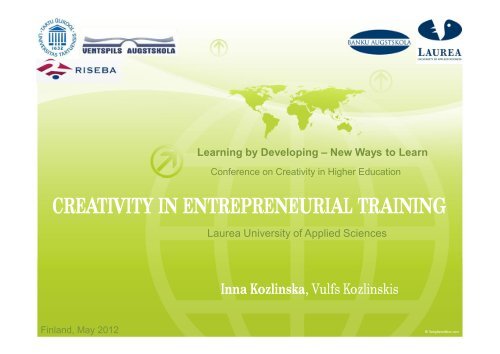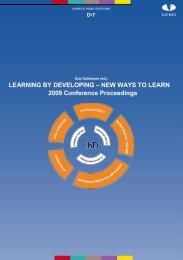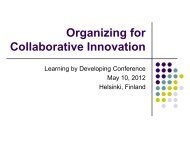CREATIVITY IN ENTREPRENEURIAL TRAINING - LbD Conference
CREATIVITY IN ENTREPRENEURIAL TRAINING - LbD Conference
CREATIVITY IN ENTREPRENEURIAL TRAINING - LbD Conference
You also want an ePaper? Increase the reach of your titles
YUMPU automatically turns print PDFs into web optimized ePapers that Google loves.
<strong>CREATIVITY</strong> <strong>IN</strong> <strong>ENTREPRENEURIAL</strong> TRA<strong>IN</strong><strong>IN</strong>G<br />
Finland, May 2012<br />
Learning by Developing – New Ways to Learn<br />
<strong>Conference</strong> on Creativity in Higher Education<br />
Laurea University of Applied Sciences<br />
Inna Kozlinska, Vulfs Kozlinskis
Agenda?<br />
Level I: Creativity<br />
Level II: Creativity in Education<br />
Level III: Creativity in Entrepreneurship Education
What is Creativity?<br />
Intelligence<br />
Personality<br />
Creativity<br />
Novelty<br />
Gains<br />
100s of definitions<br />
Popularity<br />
Success<br />
Breakthrough<br />
a skill, an ability to make unforeseen connections and to<br />
generate new and appropriate ideas in heuristic environment; a<br />
form of knowledge creation and construction of personal<br />
meaning recognised widely (Ferrari et al., 2009)
Milestones of Understanding Creativity<br />
Medieval ages: divine<br />
Ancient history: poetry & art<br />
XX-XXI: sciences & nature,<br />
scientific approach & business<br />
XVIII-XIX: “C” notion, art<br />
Renaissance: “C” word, poetry<br />
Source: Tatarkiewicz, 1980; Cropley, 2003; Lehrer, 2012
1950s<br />
1960s<br />
1970s<br />
1990s<br />
2000s<br />
Prominent Contributors to Creativity<br />
Research<br />
Guilford, Osbon, Atlshuller<br />
de Bono<br />
Aznar, Amabile<br />
Csikszentmihaly, Ludwig, Sternberg & Lubart<br />
Robinson
Creativity in Education<br />
View Approach Author/Year<br />
Creativity is<br />
inborn<br />
Creativity can be<br />
developed<br />
Creativity is both<br />
inborn and can be<br />
developed<br />
Self-expression &<br />
mystical<br />
Runco, 1999; Sharp, 2004<br />
Cognitive Osborn, 1953; de Bono, 1985, 1970;<br />
Altshuller, 1984; Aznar, 1973, 2005;<br />
Albert & Runco, 1990; Sternberg &<br />
Lubart, 1995; Amabile, 1998; etc.<br />
Psychometric Guilford, 1950<br />
Psychoanalytic Freud, 1958; Eigen, 1983<br />
Creative learning is a process which involves understanding and<br />
new awareness allowing a learner to go beyond traditional<br />
perception and thinking (Ferrari et al., 2009).
Educational and Knowledge Triangles<br />
Linked Together with Creativity<br />
Source: Ferrari et al. (2009); Heder et al. (2011)
Unique Features of Creativity<br />
production of novelty involves both creative and<br />
standardised processes (Cropley, 2003:2,19);<br />
knowledge can both foster and hinder (Ferrari et al.,<br />
2009);<br />
knowledge does not have to be acquired<br />
consciously (Reber, 1989)<br />
“chance favours the prepared mind” (Pasteur, 1854);<br />
“1% inspiration, 99% perspiration” (Edison, 1914).<br />
can be manifested only in existing domains, a<br />
person can be creative only in a domain she is<br />
exposed to (Csikszentmihalyi, 1996:29)<br />
neither intelligence nor imagination, “love, love,<br />
love, that is the soul of genius” (Mozart)
Creativity in Entrepreneurship<br />
Education<br />
What is entrepreneurship?<br />
A process of creation, management and ownership of an<br />
enterprise, which occurs as a context-dependent social and<br />
economic process, based on the nexus of two phenomena:<br />
lucrative opportunities and enterprising individuals, and<br />
contributes (new) value(s) to the society (Shane & Venkataraman,<br />
2000; Thornton and Flynn, 2003; European Commission, 2003).
What Starting-Up a Company<br />
Challenges in Personalities?<br />
“Composing, developing and applying personal<br />
goals, competence and skills.<br />
Communicating with other people and<br />
understanding the related social and economic<br />
contexts, unwritten rules and being able to<br />
generate personal and economic growth.<br />
Composing and applying own business concept<br />
and management tools”.<br />
Source: Muller & Diensberg (2011)
European Competence Framework &<br />
Entrepreneurship Education Outcomes<br />
Teaching mode Key question Educational outcomes<br />
addressed<br />
Education ABOUT<br />
Entrepreneurship<br />
Know-what Knowledge<br />
THROUGH Know-why Attitude/behaviour<br />
FOR Know-how Skills<br />
Source: based on EU (2006), Heder et al. (2011), Haase & Lautenschlager (2010)
What is entrepreneurial training?<br />
Standard teaching Training and coaching<br />
Main goal Development of critical<br />
thinking, theoretical<br />
understanding<br />
Development of competence, personality, personal goals<br />
and potentials, material/decisional achievements<br />
Perspective A student A prospective or acting founder/team of the company<br />
within her biography and social setting<br />
Methodical Knowledge<br />
Strengthening by imparting knowledge, developing<br />
focus transmission<br />
competences; drawing out wishes, abilities, dreams,<br />
goals, awareness<br />
Approach Lectures and seminars Constructing situations for problem-solving, competence<br />
development, achievement of self-congruent goals<br />
Role of<br />
educator<br />
Lecturer<br />
and/or self-development in an interpersonal relation<br />
Facilitator and expert<br />
Source: based on Muller & Diensberg (2011)
Creative<br />
(Rossman, 1931)<br />
1. Observation of a<br />
need<br />
2. Analysis of the<br />
need<br />
3. Survey of all<br />
available info<br />
4. Formulation of<br />
objective<br />
solutions<br />
5. Critical analysis<br />
of solutions<br />
6. Birth of new idea<br />
& experiments<br />
Target processes compared<br />
Creative learning<br />
(Rae, 2011)<br />
Entrepreneurial<br />
(Baron & Shane, 2008)<br />
Creative teamwork Opportunity<br />
recognition/idea<br />
Problem definition Initial analysis &<br />
decision to proceed<br />
Making creative<br />
connections<br />
Turning ideas into<br />
opportunities<br />
Designing &<br />
communicating<br />
innovation<br />
Reflecting on<br />
“special moments”<br />
Assembling the<br />
required resources<br />
Launching a new<br />
venture<br />
Building a successful<br />
business<br />
Creative entrepreneurial<br />
(Amabile, 1997)<br />
Problem identification<br />
Recognition and definition<br />
of opportunities<br />
Preparation (information<br />
gathering)<br />
Response generation (to<br />
solve the problem)<br />
Validation (formalisation of<br />
selected approach)<br />
Harvesting rewards Communication
Questions<br />
WHAT information and HOW to find?<br />
How to exploit the creative solution?<br />
How to fill in fractures in the<br />
interconnected processes?<br />
How does creativity fit into the<br />
entrepreneurial training outcomes<br />
model?
Unique Features of Entrepreneurship for Education<br />
People are the basis<br />
A profession, not science; a process<br />
Experience-based, for motivated and targeted people<br />
Complexity of decisions<br />
Focus on satisfactory/maximum profit, growth/development prospects<br />
Competition and fight for customers/market share<br />
Creation of new values and/or needs<br />
Randomness, uncertainty and ambiguity; risk-factor<br />
Opportunity-based strategies<br />
Source: based on Fillis & Rentschler (2010), Heinonen et al. (2011), Bennis & O’Toole (2005),<br />
Karhunen et al. (2011).
Componential model of creativity<br />
Component Subcomponents<br />
1. Divergent thinking & Elaboration, originality, remote associations, restructuring &<br />
doing<br />
redefinition, flexibility, fluency, problem sensitivity<br />
2. General knowledge & Metacognition, critical & evaluative thinking, reasoning & logical<br />
thinking base thinking, analysing & synthesising, memory network, etc.<br />
3. Specific knowledge Acquisition & mastery of specific knowledge & skills in specific areas<br />
base & skills<br />
of (creative) thinking & doing; expertise<br />
4. Focusing & task Topic-/object-/situation-/product-focusing concentration<br />
commitment steadfastness & persistence, task commitment, selectivity, etc.<br />
5. Motives & motivation Need for novelty, curiosity, drive for exploration & knowledge<br />
communication, self-actualisation flow, recognition, etc.<br />
6. Openness & tolerance Openness for experiences, playfulness & experimenting, readiness to<br />
of ambiguity<br />
take risks, non-conformism & autonomy, relaxation, humour, etc.<br />
Source: Cropley (2001)
Environment<br />
Creativity map for entrepreneurial training<br />
Teaching mode FOR & THROUGH FOR & THROUGH ABOUT & THROUGH<br />
Mode of mental<br />
functioning<br />
Learning<br />
outcomes<br />
-Individual<br />
dimension<br />
-Group, local<br />
dimension<br />
-Societal,<br />
historical, global<br />
dimension<br />
Affection:<br />
temperament &<br />
emotion<br />
Conation: motivation<br />
& volition<br />
Cognition: procedural &<br />
declarative knowledge<br />
Attitude/Behaviour Attitude/Behaviour Skills/Knowledge<br />
1. Divergent<br />
thinking & doing<br />
4. Focusing & task<br />
commitment<br />
6. Openness &<br />
tolerance of<br />
ambiguity<br />
4. Focusing & task<br />
commitment<br />
5. Motives &<br />
motivation<br />
6. Openness &<br />
tolerance of<br />
ambiguity<br />
1. Divergent thinking and<br />
doing<br />
2. General knowledge &<br />
thinking base<br />
3. Specific knowledge<br />
base & skills<br />
Primary process: irrational Secondary process: rational<br />
Source: devised by the authors based on P.Kyro’s (2008), EU (2006), Heder e al. (2011), Cropley<br />
(2001), Haase & Lautenschlager (2010)
THANK YOU!<br />
Contact e-mail: inna.kozlinska@ut.ee




